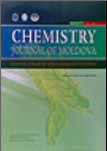Chemistry Journal of Moldova
Research paper
Author(s):
Field: Ecological chemistry
Type: Research paper
Issue: 2008 Volume 3, no.1
Pages: 70-76
Viorica Gladchi, Nelli Goreaceva, Gheorghe Duca, Elena Bunduchi, Lidia Romanciuc, Igor Mardari, Ruslan Borodaev
Field: Ecological chemistry
Type: Research paper
Issue: 2008 Volume 3, no.1
Pages: 70-76
Full Text (PDF): Download
DOI: dx.doi.org/10.19261/cjm.2008.03(1).14
Graphical Abstract: The work presented in the paper discusses the contribution of the Novodnestrovsc water system to the formation of redox conditions in the lower Dniester. The conclusions were drawn on the basis of a long-term protocol of analyses that included the analysis of the oxygen regime, evaluation of the content of hydrogen peroxide, rH2, biological oxygen demand as well as other additional parameters.
Downloads: 24
Author(s):
Field: Physical chemistry and chemical physics
Type: Research paper
Issue: 2008 Volume 3, no.1
Pages: 31-43
Ion Dranca
Field: Physical chemistry and chemical physics
Type: Research paper
Issue: 2008 Volume 3, no.1
Pages: 31-43
Full Text (PDF): Download
DOI: dx.doi.org/10.19261/cjm.2008.03(1).17
Graphical Abstract: Differential scanning calorimetry has been used to study the α-relaxation (glass transition) in virgin polystyrene (PS), PS-clay nanocomposite, amorphous indomethacin (IM), maltitol (Mt) and glucose (Gl).
Downloads: 17
Author(s):
Field: Industrial chemistry
Type: Research paper
Issue: 2008 Volume 3, no.1
Pages: 85-88
Veaceslav Boldescu,Irina Kacso, Ioan Bratub and Gheorghe Duca
Field: Industrial chemistry
Type: Research paper
Issue: 2008 Volume 3, no.1
Pages: 85-88
Full Text (PDF): Download
DOI: dx.doi.org/10.19261/cjm.2008.03(1).18
Graphical Abstract:
-β-CD) inclusion complex. Spectrophotometric studies of the SANG-β-CD systems in the presence and without 0.1 % PVP at the pH 5.0 did not show any evidence of the complex formation. However, the same systems showed several obvious evidences at the pH 8.0: the hyperchromic and the hypochromic effects and the presence of the isosbestic point in the region of 200 –210 nm. The association constants calculated by three linear methods: Benesi-Hildebrand, Scott and Scatchard, were two times higher for the systems with addition of 0.1% PVP than for the systems without it.
Downloads: 22
Downloads: 22
Author(s):
Field: Natural product chemistry and synthesis
Type: Research paper
Issue: 2007 Volume 2, no.1
Pages: 114-118
Pavel F. Vlad, Alexandru G. Ciocarlan, Grigore N. Mironov, Mihai N. Coltsa, Yurii A.Simonov, Victor Ch. Kravtsov and Janusz Lipkowski
Field: Natural product chemistry and synthesis
Type: Research paper
Issue: 2007 Volume 2, no.1
Pages: 114-118
Full Text (PDF): Download
DOI: dx.doi.org/10.19261/cjm.2007.02(1).04
Graphical Abstract: A mixture of 7α- and 17-bromonorambreinolides was obtained on treatment of the mixture of isomeric methyl bicyclohomofarnesenoates, the norambreinolide transesterification product, with NBS and H2O2. The structure of 7α- and 17-bromonorambreinolides was elucidated on the basis of spectral data. The structure of 17-bromonorambreinolide was confirmed by its reduction with LiAlH4 into sclaradiol, and that of 7α-bromonorambreinolide by X-ray analysis.
Downloads: 13
Author(s):
Field: Natural product chemistry and synthesis
Type: Research paper
Issue: 2007 Volume 2, no.1
Pages: 108-113
Irina Lunga, Pavel Chintea, Stepan Shvets, Anna Favelb and Cosimo Pizza
Field: Natural product chemistry and synthesis
Type: Research paper
Issue: 2007 Volume 2, no.1
Pages: 108-113
Full Text (PDF): Download
DOI: dx.doi.org/10.19261/cjm.2007.02(1).05
Graphical Abstract: Phytochemical analysis of the seeds of Hyocyamus niger L. (Solonaceae) resulted in the isolation of six steroidal glycosides, two furostanol (1, 2) and four spirostanol saponins (3, 4, 5, 6), which were found in this plant for the first time. The structures of these compounds were determined by detailed analysis of their spectral data, including two-dimensional NMR spectroscopy and MS spectroscopy. The antifungal activity of a crude steroidal glycoside extract, fractions of spirostanoles and individual glicosides was investigated in vitro against a panel of human pathogenic fungi, yeasts as well as dermatophytes and filamentous species.
Downloads: 51
Author(s):
Field: Inorganic and coordination chemistry
Type: Research paper
Issue: 2007 Volume 2, no.1
Pages: 102-107
Takanori Kotera, Tsukasa Sugimoto and Masahiro Mikuriya
Field: Inorganic and coordination chemistry
Type: Research paper
Issue: 2007 Volume 2, no.1
Pages: 102-107
Full Text (PDF): Download
DOI: dx.doi.org/10.19261/cjm.2007.02(1).06
Graphical Abstract: Thiolato-bridged complex [CuI4CuII4(peampt)4Cl8]·2H2O (Hpeampt = 1-(2-pyridylethyl)amino) methylpropane-2-thiol) has been synthesized and characterized by the elemental analysis, IR and UV-vis spectroscopies and magnetic susceptibility measurement. The X-ray crystal structure analysis of this complex shows a localized mixed-valence octanuclear cage structure made up of four trigonal-bipyramidal CuIIN2SCl2, two trigonal CuIS2Cl, and two tetrahedral CuIS2Cl2 coordination sites. Temperature dependence of magnetic susceptibility (4.5— 300 K) shows that a fairly strong antiferromagnetic interaction is operating between the four CuII ions.
Downloads: 23
Author(s):
Field: Inorganic and coordination chemistry
Type: Research paper
Issue: 2007 Volume 2, no.1
Pages: 98-101
Adina N. Lazar, Oksana Danylyuk, Kinga Suwinska and Anthony W. Coleman
Field: Inorganic and coordination chemistry
Type: Research paper
Issue: 2007 Volume 2, no.1
Pages: 98-101
Full Text (PDF): Download
DOI: dx.doi.org/10.19261/cjm.2007.02(1).07
Graphical Abstract: T
Downloads: 15
Author(s):
Field: Inorganic and coordination chemistry
Type: Research paper
Issue: 2007 Volume 2, no.1
Pages: 93-97
Shtemenko A.V., Tretyak S.Y., Golichenko A.A.
Field: Inorganic and coordination chemistry
Type: Research paper
Issue: 2007 Volume 2, no.1
Pages: 93-97
Full Text (PDF): Download
DOI: dx.doi.org/10.19261/cjm.2007.02(1).08
Graphical Abstract: The interaction of cis-Re2(RCOO)2Cl4, trans-Re2(RCOO)2Cl4, Re2(RCOO)3Cl3 and Re2(RCOO)4Cl2 (where R - alkyl group) with 1,3,5-triphenylverdazyle radical in 1,2-dichlorethane was investigated. It is discovered, that gradual substitution of halogenide ligands by carboxylates in dirhenium(III) clusters led to slowing down of reaction with a radical due to different influence of these ligands on parameters of rhenium - rhenium bond. Presented data showed perspectivity of Re26+-substances applications as therapeutic agents due to their low toxicity and antiradical properties that occured by δ-component of quadruple Re-Re bond electron transition.
Downloads: 16
Author(s):
Field: Inorganic and coordination chemistry
Type: Research paper
Issue: 2007 Volume 2, no.1
Pages: 88-92
Krisztina Kovács, Alexander A. Kamnev, Alexei G. Shchelochkov, Ernő Kuzmann, János Mink 3, Tünde Megyes, Attila Vértes
Field: Inorganic and coordination chemistry
Type: Research paper
Issue: 2007 Volume 2, no.1
Pages: 88-92
Full Text (PDF): Download
DOI: dx.doi.org/10.19261/cjm.2007.02(1).09
Graphical Abstract: Interactions of a series of indole-3-alkanoic acids (with n-alkanoic acid side-chains from C1 to C4) with iron(III) in acidic aqueous solutions have been shown to comprise two parallel processes including complexation and redox transformations giving iron(II) hexaaquo complexes. The structure and composition of the reaction products are discussed, as analysed using a combination of instrumental techniques including 57Fe Mössbauer, vibrational and HNMR spectroscopies.
Downloads: 13
Author(s):
Field: Inorganic and coordination chemistry
Type: Research paper
Issue: 2007 Volume 2, no.1
Pages: 83-87
Sergiy Smola, Natalya Rusakova, Elena Martsinko, Inna Seifullina, Yuriy Korovin
Field: Inorganic and coordination chemistry
Type: Research paper
Issue: 2007 Volume 2, no.1
Pages: 83-87
Full Text (PDF): Download
DOI: dx.doi.org/10.19261/cjm.2007.02(1).10
Graphical Abstract: Four new heteronuclear lanthanide complexes with general formula [Ge(OH)(μ-HDTPA)LnGe(OH) (μ-DTPA)] (Ln = Sm – Dy) were synthesized and subsequently characterized by different physico- chemical methods. The structures of new compounds have been proposed. In considered complexes the 4f-luminescence of three-charged ions of samarium, europium, terbium and dysprosium is realized at UV-excitation. It is noteworthy that it is the first observation of 4f-luminescence in water solutions of heteronuclear f-p-complexes. The comparison of luminescent characteristics of hetero- and homonuclear landthanide complexes is described and discussed as well.
Downloads: 18






